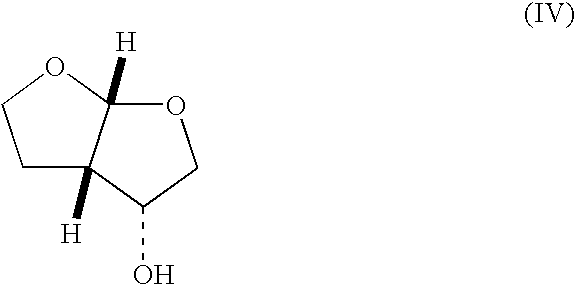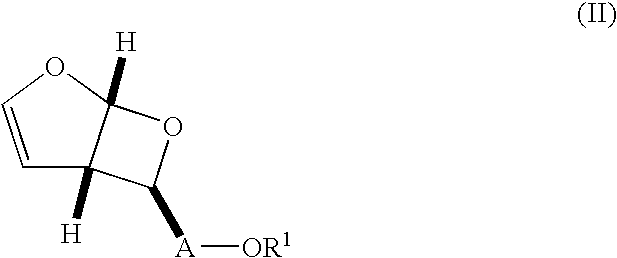Process for preparing protease inhibitor intermediates
a technology of protease inhibitors and intermediates, which is applied in the field of preparation of cyclic alcohol intermediates, can solve the problems of difficult preparation in a cost-effective and efficient manner, chemical complexity of protease inhibitors in general, and the method of synthesis of pharmaceutical intermediates is difficul
- Summary
- Abstract
- Description
- Claims
- Application Information
AI Technical Summary
Benefits of technology
Problems solved by technology
Method used
Image
Examples
example i
[0078]
wherein R1 is —C(CH3)3, is reacted with an agent capable of acting as a Lewis acid or a Brönsted acid to afford a compound of formula (IV).
[0079]Preferred Lewis acids include boron trifluoride etherate, iron (III) chloride on silica, tin (IV) chloride, zinc (II) bromide, or aluminum (III) chloride and preferred solvents are tetrahydrofuran, dichloromethane, or chloroform.
[0080]Preferred Brönsted acids include trifluoroacetic acid, sulfuric acid, nitric acid, hydrobromic acid, or, most preferably, hydrochloric acid. Preferred solvents include methanol, ethanol, tetrahydrofuran, water, a mixture of tetrahydrofuran and water, or, most preferably, 2,2,2-trifluoroethanol.
example ii
[0081]
wherein R1 is —Si(R3)4, wherein R3 is C1-8 alkyl, is reacted with an agent capable of cleaving the silyl protecting group to afford a compound of formula (II), wherein R1 is hydrogen. Although any appropriate agent capable of cleaving the silyl-protecting group may be used, preferably the cleavage is performed with hydrochloric acid in tetrahydrofuran and water to afford the alcohol of formula (IV).
[0082]Additionally, compounds of formula +N(R3)4X−, wherein each R3, which may be the same or different, are selected from the group consisting of C1-8alkyl and C6-14-aryl, and X is fluorine may be used. These agents are commercially available or can be prepared by methods known in the art. The cleaving reactions are typically performed in a solvent such as methanol, ethanol, tetrahydrofuran, tetrahydrofuran and water, chloroform, or, dichloromethane. The cleaving reactions are performed at a temperature from about 0° C. to 50° C., and more preferably at about ambient temperatures. ...
example iii
[0086]As noted above, an alternate embodiment of the present invention includes treatment of the oxetane (formula (II)) to a reduction / deprotection / rearrangement reaction to afford directly a cyclic alcohol (formula (IV)). Thus,
[0087]
wherein A is —CH2— and R1 is —C(R2)3, where two R2 are H, or two R2 are CH3, and one R2 is C6-14 aryl, is reacted with 5% by weight palladium on carbon in combination with formic acid, ammonium formate, or preferably hydrogen. More preferably, 10% by weight palladium on carbon is used in combination with hydrogen. These reactions preferably are conducted in a solvent such as methyl alcohol, ethyl alcohol, or, more preferably, tetrahydrofuran. In addition, these reactions preferably are conducted at a temperature from about 10° C. to 50° C., more preferably at about ambient temperature.
PUM
| Property | Measurement | Unit |
|---|---|---|
| wavelength | aaaaa | aaaaa |
| wavelength | aaaaa | aaaaa |
| wavelength | aaaaa | aaaaa |
Abstract
Description
Claims
Application Information
 Login to View More
Login to View More - R&D
- Intellectual Property
- Life Sciences
- Materials
- Tech Scout
- Unparalleled Data Quality
- Higher Quality Content
- 60% Fewer Hallucinations
Browse by: Latest US Patents, China's latest patents, Technical Efficacy Thesaurus, Application Domain, Technology Topic, Popular Technical Reports.
© 2025 PatSnap. All rights reserved.Legal|Privacy policy|Modern Slavery Act Transparency Statement|Sitemap|About US| Contact US: help@patsnap.com



